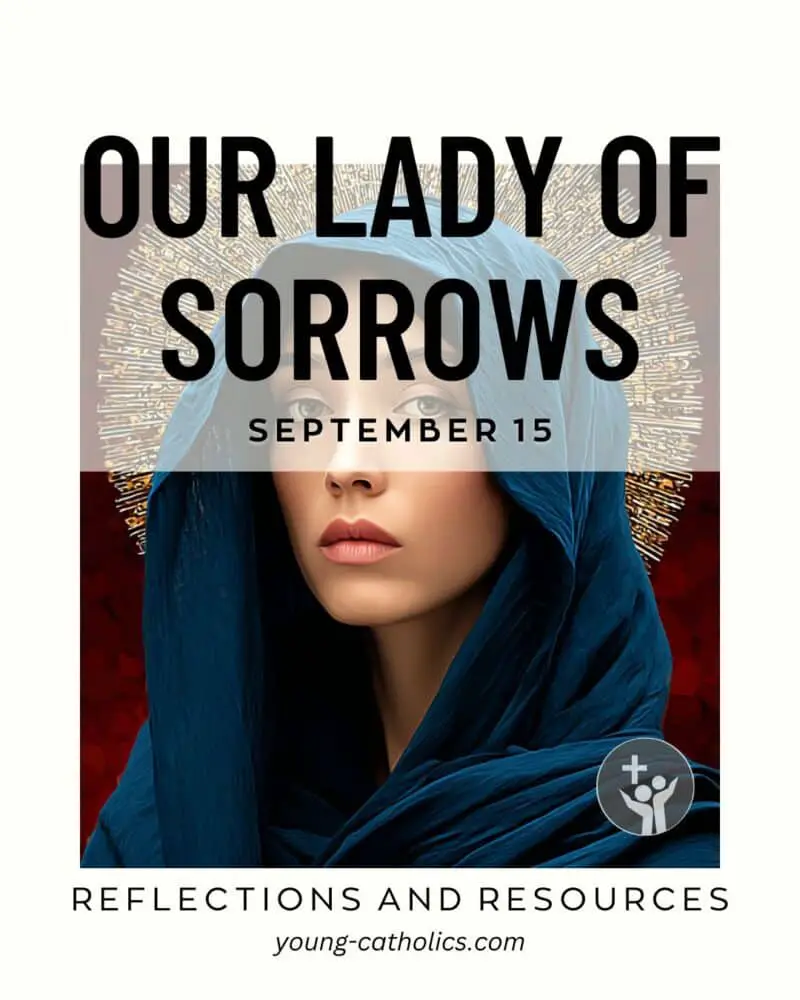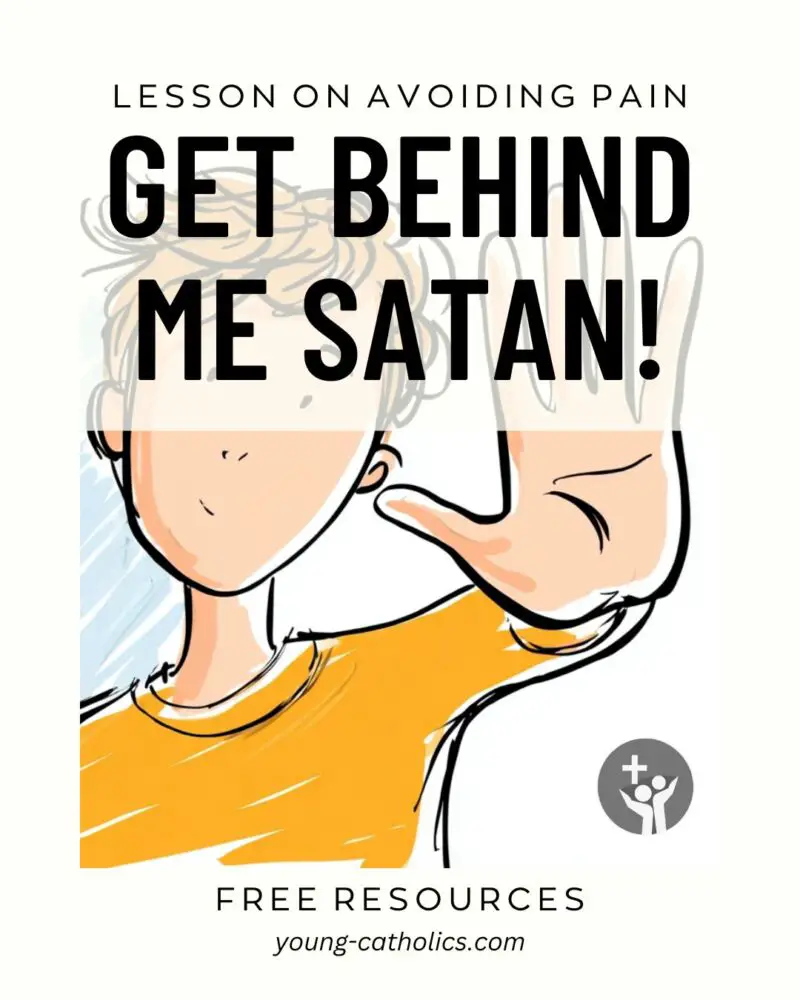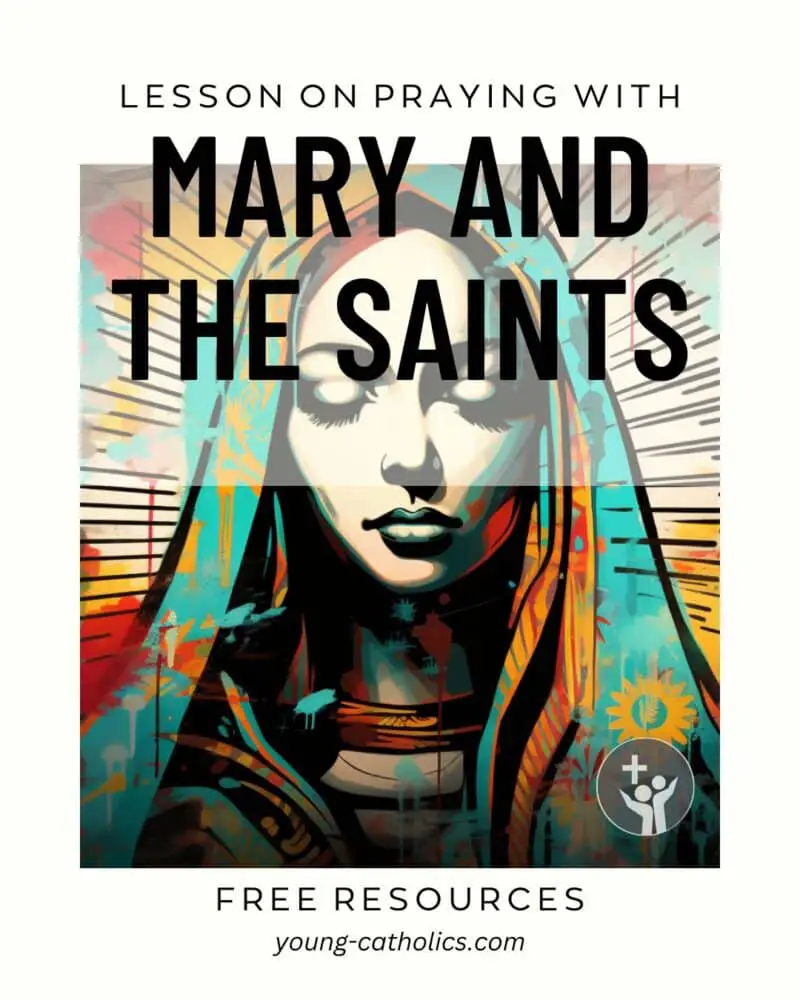Our Lady of Sorrows
Feast Day: September 15

Our Lady of Sorrows is a special title given to Mary, the mother of Jesus. This title reminds us of the deep sadness she felt during her life. Mary faced many hard times, especially when she saw her son suffer and die.
People honor Our Lady of Sorrows because she shows great strength and love. She went through seven main sorrows, like when she lost young Jesus in the temple and when she stood by the cross as he died. These moments show how much she cared and how brave she was.
By thinking about Mary’s sorrows, we can learn to face our own troubles with courage. She teaches us to stay strong and to trust in God, even when things are hard. Mary’s example helps us understand that sadness can bring us closer to others and to God.
Many churches and believers remember Our Lady of Sorrows through prayers and special days. They find comfort in knowing that Mary understands their pain. By honoring her, they feel supported and less alone in their own sorrows.
From Sorrow to Strength: The Beginnings of a Devotion
The devotion to Our Lady of Sorrows began many years ago. People wanted to honor Mary for the deep sadness she felt during her life. They focused on her sorrow because it showed her great love and courage.
In the 13th century, a group called the Servites helped spread this devotion. They encouraged others to remember the seven major sorrows that Mary faced. These included moments like when she lost young Jesus in the temple and when she saw him die on the cross.
Learn more about the Servites here.
The title “Our Lady of Sorrows” grew in importance within the Church. It became a way to honor Mary’s suffering and her strong faith. The Church saw value in her example and wanted others to find comfort in her story.
A special day was set aside to remember Our Lady of Sorrows. This showed how much the Church valued her experience and wanted people to reflect on her life. Through her sorrows, many found a connection to their own struggles.
The devotion became important because it offered hope. By thinking about Mary’s hardships, people learned to face their own troubles with strength. Her story showed that even in deep sadness, there is a path to peace.
Seven Sorrows: Moments When Mary’s Heart Ached
Mary faced seven deep sorrows in her life. These moments were hard for her, but they show her strong love and faith.
The Prophecy of Simeon
When Jesus was a baby, Mary and Joseph took him to the temple. A man named Simeon told Mary that Jesus would be important, but also that she would feel great pain. He said a sword would pierce her heart. This made Mary sad because she knew hard times would come.
The Flight into Egypt
King Herod wanted to harm baby Jesus. An angel warned Joseph in a dream. So, Mary, Joseph, and Jesus left their home quickly. They fled to Egypt to keep Jesus safe. The journey was long and difficult. Mary worried about her child and missed her home.
The Loss of the Child Jesus in the Temple
When Jesus was twelve, the family went to Jerusalem. On the way home, Mary and Joseph realized Jesus was missing. They searched for three days. Finally, they found him in the temple, talking with teachers. Mary was anxious and asked why he stayed behind. Jesus said he was doing his Father’s work.
Meeting Jesus on the Way to Calvary
As Jesus carried his cross to Calvary, Mary saw him on the road. She watched her son suffer as he walked to his death. Seeing Jesus in pain hurt her deeply, but she stayed close to him.
The Crucifixion of Jesus
Mary stood near the cross as Jesus was crucified. She heard his words and saw his suffering. Watching her son die was the hardest moment for her. Still, she remained by his side until the end.
The Taking Down of Jesus from the Cross
After Jesus died, they took his body down from the cross. They placed him in Mary’s arms. She held her son one last time. Her sorrow was great as she looked at his lifeless body.
The Burial of Jesus
Mary watched as they laid Jesus in the tomb. A stone was rolled over the entrance. Her son was gone, and she felt deep sadness. Yet, she trusted that this was part of God’s plan.
A Day to Remember
Every year on September 15, we honor Our Lady of Sorrows. This special day helps us remember the deep sadness that Mary, the mother of Jesus, felt. It is a time to think about her pain and how she stayed strong.
The Church chose this date to follow the feast of the Exaltation of the Holy Cross on September 14. This shows the close link between Jesus’s suffering and Mary’s sorrows. By remembering her on this day, we join her in her moments of sadness.
On this feast day, many churches hold special services. People pray and reflect on the seven sorrows of Mary. They may read scriptures that tell about these sad times. Hymns and songs about Mary’s sorrow are often sung.
Some people attend Mass to honor Our Lady of Sorrows. During the service, they might hear sermons about Mary’s strength and love. Priests may wear blue or purple vestments to symbolize mourning and reflection.
In some places, people hold processions with statues of Our Lady of Sorrows. They might carry candles and pray together. These traditions help communities come together to support each other, just as Mary stood by Jesus.
By marking this day, we show our respect and love for Mary. We remember her sorrows and learn from her example. She teaches us to stay faithful and strong, even when life is hard.
Ways to Honor Our Lady of Sorrows
Many people turn to Our Lady of Sorrows in prayer. They find comfort in connecting with Mary, who understands deep sadness. There are special prayers and novenas dedicated to her. A novena is a prayer said over nine days. These prayers ask for Mary’s help and guidance.
One popular prayer is the Chaplet of the Seven Sorrows. This chaplet is like a rosary but focuses on Mary’s seven sorrows. As people pray, they think about each sorrow and what it means. This helps them feel closer to Mary and learn from her strength.
Some believers wear a special item called the Scapular of the Seven Sorrows. A scapular is two small pieces of cloth connected by strings and worn over the shoulders. It is a sign of devotion to Our Lady of Sorrows. Wearing it reminds people to live with compassion and patience.
Other sacramentals, like medals and pictures, also honor Our Lady of Sorrows. These items help people remember Mary’s sorrows and her love. By using them, believers feel supported in their own times of trouble.
Through these prayers and items, many find hope and peace. They feel connected to Mary and to others who share this devotion. It is a way to keep her memory alive and to learn from her example.
How to Pray the Chaplet of the Seven Sorrows
Praying the Chaplet of the Seven Sorrows is a way to join Mary in remembering her deepest sorrows. This prayer helps us reflect on her pain and find comfort in her strength. Here’s how you can pray it:
Begin with the Sign of the Cross.
- This marks the start of your prayer.
Pray an Act of Sorrow.
- Tell God you are sorry for your sins and ask for forgiveness.
First Sorrow: The Prophecy of Simeon
- Think about when Simeon told Mary that a sword would pierce her heart.
- Pray one Our Father and seven Hail Marys, reflecting on this sorrow.
Second Sorrow: The Flight into Egypt
- Imagine Mary and Joseph fleeing to Egypt to protect baby Jesus.
- Pray one Our Father and seven Hail Marys, considering their fear and trust.
Third Sorrow: The Loss of the Child Jesus in the Temple
- Recall how Mary felt when she couldn’t find Jesus for three days.
- Pray one Our Father and seven Hail Marys, feeling her anxiety and relief.
Fourth Sorrow: Meeting Jesus on the Way to Calvary
- Picture Mary meeting Jesus as he carries the cross.
- Pray one Our Father and seven Hail Marys, sharing in her pain.
Fifth Sorrow: The Crucifixion of Jesus
- Reflect on Mary’s sorrow as she watches her son die on the cross.
- Pray one Our Father and seven Hail Marys, honoring her courage.
Sixth Sorrow: Taking Jesus Down from the Cross
- Think about Mary holding Jesus after he was taken down from the cross.
- Pray one Our Father and seven Hail Marys, acknowledging her grief.
Seventh Sorrow: The Burial of Jesus
- Remember Mary’s sadness as Jesus is laid in the tomb.
- Pray one Our Father and seven Hail Marys, contemplating her hope.
Conclude the Prayer
- Pray three Hail Marys in honor of Mary’s tears.
- Finish with the Sign of the Cross.
By praying this chaplet, we walk with Mary through her sorrows. It helps us find strength in our own struggles and grow closer to her and to God.
Images That Speak: Art and Symbols of Our Lady of Sorrows
Artists have long shown Our Lady of Sorrows in paintings and sculptures. These artworks display Mary during her moments of deep sadness. They help us feel connected to her story and understand her pain.
A common symbol is Mary with seven swords piercing her heart. The seven swords stand for her seven sorrows. This image shows the heavy burden she carried in her life. Sometimes, artists paint her with tears on her cheeks to express her grief.
One famous artwork is the Pietà by Michelangelo in St. Peter’s Basilica in Rome. It shows Mary holding the body of Jesus after he was taken down from the cross. Her face is calm but sad, reflecting her deep love and sorrow.
Statues of Our Lady of Sorrows are found in many churches around the world. In some countries, people carry these statues in processions during special times like Holy Week. This tradition helps communities remember Mary’s suffering and feel her close to them.
These artworks use symbols to tell Mary’s story without words. They remind us of her strength and her caring heart. By looking at them, we can find comfort and feel less alone in our own hardships.
A Mother’s Sorrow: Mary During Jesus’s Suffering
Mary had a key role in the suffering and death of Jesus. As his mother, she felt deep pain seeing her son go through such hard times. She stayed close to him during his final moments.
When Jesus was arrested and put on trial, Mary did not run away. She followed him as he carried his cross to the place called Calvary. Standing by the cross, she watched her son suffer and knew there was nothing she could do to stop it.
Mary’s heart was full of sorrow, but she remained faithful. She trusted that there was a purpose to this pain. Her strong belief in God helped her endure the unbearable.
Through her suffering, Mary showed great compassion. She shared in Jesus’s pain and offered her support. Her presence gave him comfort, even as he faced death.
Mary’s example teaches us about obedience and faith. She accepted God’s plan, even when it meant losing her son. Her trust in God did not waver, and she stayed faithful to the end.
By being with Jesus in his darkest hour, Mary became part of the story of hope and redemption. Her sorrow turned to joy when Jesus rose from the dead. She shows us how to stay strong in our own times of trouble.
Finding Hope Today: Our Lady of Sorrows in Modern Life
The devotion to Our Lady of Sorrows still matters today. Many people find comfort in Mary’s story because she understands pain and loss. Her example helps us deal with our own hardships.
Our Lady of Sorrows has inspired many works of art, books, and music. Artists use her image to express deep feelings. Writers tell stories that reflect her courage and love. Musicians compose songs that capture her sorrow and hope.
In some places, people have reported seeing Mary appear, sharing messages of comfort and warning. These Marian apparitions often focus on themes of sorrow and compassion. They remind us to care for each other and to turn back to God.
By thinking about Mary’s sorrows, we learn to face our own struggles with strength. Her story teaches us to have compassion for others who are suffering. This devotion encourages us to be kinder and more understanding in our daily lives.
A World of Traditions: Honoring Mary Across Cultures
People around the world honor Our Lady of Sorrows in special ways. Different cultures have unique customs to remember Mary’s sorrows.
In Spain, especially in Andalusia, they hold processions during Holy Week. Statues of Our Lady of Sorrows are carried through the streets. People follow, singing and praying. This shows their deep respect and love for Mary.
In the Philippines, many churches have statues of Our Lady of Sorrows. During Lent, they decorate these statues with black veils. People visit the churches to pray and reflect on Mary’s suffering.
In Italy, the town of Castelpetroso has a special shrine dedicated to Our Lady of Sorrows. Many pilgrims go there to pray. On her feast day, September 15, they hold a big celebration with Mass and processions.
In Latin America, countries like Mexico and Guatemala honor Mary with festivals. They have parades with music and dancing. People make altars in their homes with pictures of Our Lady of Sorrows. Families gather to pray and share meals.
These traditions help people feel close to Mary. By honoring her sorrows, they find strength in their own lives. Each culture adds its own touch, but the love for Mary is the same everywhere.
Daily Mass Readings for the Memorial of Our Lady of Sorrows
The Gospel for this memorial is proper (required). The first reading may be taken from the weekday or the reading found below. The sequence is optional.
- First Reading – Hebrews 5:7-9: In his earthly life, Christ Jesus offered prayers to God, learning obedience through suffering. Although a Son, he was made perfect through this process, becoming the source of eternal salvation for those who obey him.
- Responsorial Psalm – Psalm 31: In me, O LORD, find your refuge and never be ashamed. I will rescue you swiftly, be your rock and fortress, and guide you. Trust in me to control your destiny and show great goodness.
- Sequence – Stabat Mater: The mournful Mother stands near the cross, sharing Jesus’ anguish. She watches her son, tortured and dying for the sins of his nation. She prays to share in his pain and for eternal salvation through him.
- Gospel – John 19:25-27: Jesus sees his mother and a beloved disciple near the cross. He tells his mother to regard the disciple as her son, and instructs the disciple to consider her as his mother. The disciple takes her home from then on.
- Alternate Gospel – Luke 2:33-35: Jesus’ parents are amazed by Simeon’s words. Simeon tells Mary that Jesus is destined to impact many in Israel, will be a subject of contradiction, and that she too will suffer, revealing people’s thoughts.
Homilies, Commentaries, and Reflections
Finding Strength in Mary’s Sorrows
Our Lady of Sorrows shows us how to face pain and sadness with courage. Mary, the mother of Jesus, went through many hard times. She felt deep sorrow when she saw her son suffer and die. Yet, she stayed strong and kept her faith.
Mary’s sorrows teach us that it’s okay to feel sad when we face troubles. She reminds us that we are not alone in our pain. By looking at her life, we can find comfort and hope. We can learn to trust that hard times can lead to something good.
When we face our own sorrows, we can think of Mary and find strength. She shows us that even in the darkest moments, we can hold on to our faith. Her example encourages us to support others who are hurting, just as she stood by her son.
Mary’s story invites us to be compassionate and understanding. She teaches us to care for others and to share their burdens. By following her example, we can make a positive difference in the lives of those around us.
Reflection Questions
- How does Mary’s faith inspire me to hold on to hope during difficulties?
- How can I find strength in my own times of sorrow by looking at Mary’s example?
- In what ways can I support others who are going through hard times?
Check Your Response Time
Matthew Kelly reflects on the moment at the cross when Jesus entrusted Mary to John. John responded right away, showing the kind of immediacy often seen when people answer God’s call in Scripture. This raises the question of how quickly we respond when God asks something of us. Do we act at once, or do we delay, resist, or even reject what God is asking?
In his message for the Memorial of Our Lady of Sorrows, Matthew Kelly compares our response to that of teenagers who resist or ignore requests from their parents. He challenges us to notice how we respond to the Spirit’s prompting in daily life. The call is to be mindful, open, and ready, so that when God speaks, we answer without delay. By doing this, we live with a heart ready to be bold and truly Catholic in our actions.
A Family Formed at the Cross
At the foot of the cross, Jesus gave Mary to John and John to Mary. This moment shows not just concern for Mary’s future but also the creation of a new family bound together in faith. Jesus gave His mother someone who would not only care for her but also love and cherish her. In the same way, we are brought into this new family of faith, called to care for one another with compassion and devotion.
Msgr. James Vlaun reflects on how this gift from Jesus is the foundation of the Church. Through His words, we are invited to see each other as brothers and sisters, entrusted to provide and care in real ways. On the Memorial of Our Lady of Sorrows, we remember that Christ’s compassion for Mary at the cross is the same compassion He calls us to show to one another, forming us into His living family.
Entrusting Mary’s Role
In the reflection for Our Lady of Sorrows, Bishop Robert Barron talks about the moment Jesus entrusts Mary to his disciple John while on the cross.
Bishop Barron notes this supports the ancient tradition that John took Mary with him to Ephesus, where they both lived out their days. Mary is not just a historical figure or a spiritual example; she remains an active presence in the life of the Church. By entrusting Mary to John, Jesus essentially entrusts her to all his followers throughout history, emphasizing her ongoing role.
The Sorrowful Mother
This USCCB video commemorates the Feast of Our Lady of Sorrows, emphasizing the significance of Mary’s sorrow as she witnessed her innocent son’s sacrifice on the cross. Despite her Immaculate Conception, Mary’s suffering was profound. We remember the moment when Jesus entrusted Mary to the disciple whom He loved, symbolizing Mary as the mother of the Church.
We must unite our sufferings with the Cross of Christ and cultivate a devotion to Mary, who desires to be present in our times of suffering to help us find solace and align our suffering with the glory of God.
Why Our Lady of Sorrows?
In this reflection from Word on Fire, Fr. Steve Grunow discusses the concept of Our Lady of Sorrows, focusing on the sacrifices and pain Mary endured as the Mother of God. He mentions poet Wendell Berry’s view that love inevitably involves sacrifice and pain.
Fr. Grunow emphasizes that the Incarnation is a real, flesh-and-blood event that includes real love and therefore real pain. He states that Mary’s deep relationship with Christ didn’t shield her from life’s painful experiences; instead, it amplified them. Yet, through her faith, she exemplifies that divine life can be accessed even in suffering, teaching us about the depths of true love.
Resources

Get Behind Me Satan – A Lesson Plan on Avoiding Pain
This lesson plan explores the concept that accepting the Christian life involves facing challenges and even pain. It delves into the significance of Mary’s willingness to say yes to God despite understanding that love often entails sacrifice. It discusses the passage where Jesus rebukes Peter by saying, “Get behind me Satan,” emphasizing that avoiding pain can be a temptation that hinders the path of discipleship.
This reflection is particularly relevant for the Feast of Our Lady of Sorrows, which commemorates Mary’s deep sorrow and sacrifice in her journey as the mother of Jesus.

Why Do Catholics Have Devotions to Mary?
This lesson plan provides an explanation of Catholic devotions and prayers directed towards the Blessed Mother and the saints. It underscores the belief that all baptized individuals are part of the mystical body of Christ, emphasizing the interconnectedness within the faith community. The practice of praying for one another is highlighted, drawing from biblical references that encourage such intercessory prayer.
The lesson plan also clarifies the Catholic tradition of seeking the prayers of the Blessed Mother and the saints, offering insights into the significance of feasts like Our Lady of Sorrows in fostering a deeper understanding of this aspect of the faith.
Social Media Graphics and Bulletin Artwork
If you would like an image to be made available as a specific product (card, poster, mug, etc.) or as an extra high resolution image for personal use just post a comment about what you want and we will create a link to our online store for you.
Radiance of Sorrowful Grace

Honor the faith and strength of Our Lady of Sorrows with this beautiful artwork. Available as a poster, card, canvas print, home décor item, and more, it is also offered as a digital download for immediate use. Explore this inspiring image today and bring a meaningful expression of Mary’s love and courage into your space.
Click on the image for more information on how to get the full sized artwork.
Paid subscribers may download a large copy this digital artwork without watermarks, suitable for use in bulletins, social media, newsletters, etc., free of charge by clicking here. You must be logged in as a paid subscriber to access the file.
Only current paid subscribers have the rights to use the artwork.
Questions and Answers
Who is Our Lady of Sorrows?
Our Lady of Sorrows is a title given to Mary, the mother of Jesus. It highlights the deep sadness she felt during her life, especially during Jesus’s suffering and death.
What are the Seven Sorrows of Our Lady of Sorrows?
The Seven Sorrows are important moments when Mary felt great sadness:
- The Prophecy of Simeon.
- The Flight into Egypt.
- The Loss of the Child Jesus in the Temple.
- Meeting Jesus on the Way to Calvary.
- The Crucifixion of Jesus.
- Taking Jesus Down from the Cross.
- The Burial of Jesus.
Why do people honor Our Lady of Sorrows?
People honor Our Lady of Sorrows to remember Mary’s suffering and to find comfort in her example. She shows strength and faith during hard times.
When is the Feast of Our Lady of Sorrows?
The Feast of Our Lady of Sorrows is on September 15 each year. It is a special day to remember Mary’s sorrows.
How do people pray to Our Lady of Sorrows?
Many pray the Chaplet of the Seven Sorrows or say special novenas. They reflect on each of Mary’s sorrows and ask for her help and guidance.
What is the Chaplet of the Seven Sorrows?
It is a prayer that focuses on the seven sorrows of Our Lady of Sorrows. It helps people meditate on Mary’s pain and find strength.
Are there symbols associated with Our Lady of Sorrows?
Yes, common symbols include seven swords piercing Mary’s heart and images of her with tears. These represent her seven sorrows and deep sadness.
How is Our Lady of Sorrows depicted in art?
Artists often show her in moments of sorrow, like holding Jesus after the crucifixion. Famous works include the Pietà by Michelangelo.
What can we learn from Our Lady of Sorrows?
We can learn to face our own troubles with courage and faith. Our Lady of Sorrows teaches us about compassion, strength, and trust in God.
How do different cultures honor Our Lady of Sorrows?
Around the world, people have unique traditions. Some hold processions, others decorate statues, and many pray together to honor Our Lady of Sorrows.
A Woman of Strength and Compassion
Our Lady of Sorrows is a title for Mary, the mother of Jesus. It focuses on the deep sadness she experienced in her life. Mary faced many painful moments, especially during the suffering and death of her son.
These painful moments are called the Seven Sorrows. They include when Simeon told her that a sword would pierce her soul, the flight into Egypt to escape danger, and losing young Jesus in the temple. They also cover meeting Jesus on the way to the cross, standing by as he was crucified, holding his body after he died, and watching as he was buried.
People honor Our Lady of Sorrows to remember Mary’s strength and compassion. By thinking about her sorrows, we can find comfort in our own hard times. Mary’s example teaches us to stay strong and keep our faith during difficulties.
Many pray special prayers like the Chaplet of the Seven Sorrows. Different cultures have their own ways of honoring her. Through these practices, believers feel closer to Mary and find support in her story.
Your Turn
Let’s take time to learn more about Our Lady of Sorrows. Her story can help us face our own challenges with courage. By understanding her sorrows, we might find comfort in our struggles. Please share your thoughts and experiences in the comments below. Your insights could inspire others on their journey.


Leave a Reply